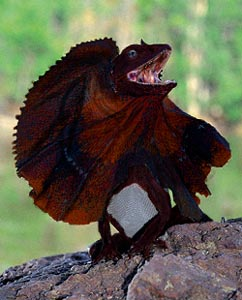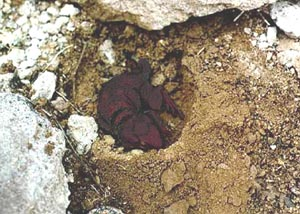Difference between revisions of "Kenkara"
From World of Entorais Wiki
Jump to navigationJump to search (applied template) |
m (Text replacement - "Sub-Species" to "Notable Sub-Species") |
||
| (5 intermediate revisions by the same user not shown) | |||
| Line 1: | Line 1: | ||
== | [[File:kenkara_male.png|thumb|right|100x|Kenkara Male - digital photo manipulation by "Sebastian Romu"]] | ||
[[File:kenkara_female.png|thumb|right|100x|Kenkara Female on Nest - digital photo manipulation by "Sebastian Romu"]] | |||
;Common Names: | ==About== | ||
;Common Names:Kenkara | |||
;Description:These lizards are common predators and scavengers on the Plains of Tekara. They are renowned for their ability to strip the carcass of a dead animal in a matter of hours, often aggressively defending the feast from larger scavengers. | |||
==Description== | ==Description== | ||
;Classification: | ;Classification:reptile | ||
;Size: | ;Size:The average adult Kenkara is 6-7 kg in mass, and measures 50-70 cm in total length of which about one third is tail. | ||
;Appearance: | ;Appearance:Their scales range from dull red through black in colour, with a pale grey underbelly. They possess an opposable digit on all six feet. | ||
;Sexual dimorphism: | ;Sexual dimorphism:The males of the species have a neck frill of brighter colours that is flared to scare off larger scavengers. The male’s frill is also used in mate selection, and displayed repeatedly during mating. | ||
==Ecology== | ==Ecology== | ||
;Habitat: | ;Habitat:Prairie and scrubland. Found primarily in the [[Plains of Tekara]]. | ||
;Diet: | ;Diet:Generally carnivorous, Kenkara hunt eat a variety of smaller animals, will raid the nests of birds and other lizards for eggs or young, and will scavenge from the carcasses of larger animals, killed by other predators. | ||
==Behaviour== | ==Behaviour== | ||
;Social grouping: | ;Social grouping:They are found in packs of up to a dozen animals. | ||
;Temperament: | ;Temperament:Neutral. Aggressive when encountered near food source. | ||
;Intelligence: | ;Intelligence:Cunning animals. Kenkara are also known to be capable problem solvers and thus are difficult to trap. | ||
;Reproduction: | ;Reproduction:Females will lay just shy of a dozen eggs and brood them in a shallow scraped hollow. Once the eggs hatch the female leaves to join her group. Her brood are left to fend for themselves, and will often be found later as an adult pack. | ||
==Sub-Species== | ==Notable Sub-Species== | ||
<--list of sub-species with notable differences--> | <!--list of sub-species with notable differences--> | ||
==Domestication== | ==Domestication== | ||
;General:<-- | ;General:None. | ||
; | ;Resources:Meat. | ||
==Stories== | |||
<div style="column-count:3;-moz-column-count:3;-webkit-column-count:3"> | |||
</div> | |||
==See Also== | ==See Also== | ||
<--links to related material--> | <!--links to related material--> | ||
[[Category:Fauna]] | [[Category:Fauna]] | ||
[[Category: | [[Category:Reptile]] | ||
Latest revision as of 01:58, 20 April 2023
About
- Common Names
- Kenkara
- Description
- These lizards are common predators and scavengers on the Plains of Tekara. They are renowned for their ability to strip the carcass of a dead animal in a matter of hours, often aggressively defending the feast from larger scavengers.
Description
- Classification
- reptile
- Size
- The average adult Kenkara is 6-7 kg in mass, and measures 50-70 cm in total length of which about one third is tail.
- Appearance
- Their scales range from dull red through black in colour, with a pale grey underbelly. They possess an opposable digit on all six feet.
- Sexual dimorphism
- The males of the species have a neck frill of brighter colours that is flared to scare off larger scavengers. The male’s frill is also used in mate selection, and displayed repeatedly during mating.
Ecology
- Habitat
- Prairie and scrubland. Found primarily in the Plains of Tekara.
- Diet
- Generally carnivorous, Kenkara hunt eat a variety of smaller animals, will raid the nests of birds and other lizards for eggs or young, and will scavenge from the carcasses of larger animals, killed by other predators.
Behaviour
- Social grouping
- They are found in packs of up to a dozen animals.
- Temperament
- Neutral. Aggressive when encountered near food source.
- Intelligence
- Cunning animals. Kenkara are also known to be capable problem solvers and thus are difficult to trap.
- Reproduction
- Females will lay just shy of a dozen eggs and brood them in a shallow scraped hollow. Once the eggs hatch the female leaves to join her group. Her brood are left to fend for themselves, and will often be found later as an adult pack.
Notable Sub-Species
Domestication
- General
- None.
- Resources
- Meat.

